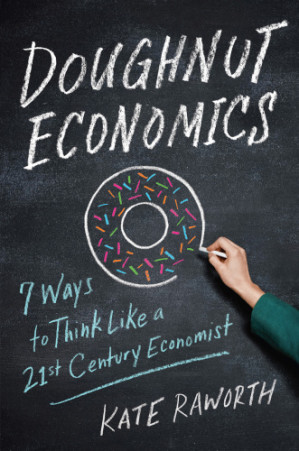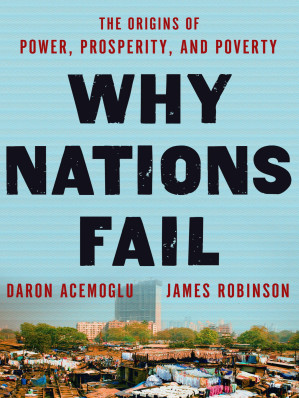The Doughnut: A visual framework for 21st-century prosperity.
Humanity's 21st century challenge is to meet the needs of all within the means of the planet.

Book summary
by Kate Raworth
Seven Ways to Think Like a 21st-Century Economist
New economic model balancing human needs with planetary boundaries
Topics
Read this book as a toolkit for economic redesign—work through one of Raworth's seven ways to think like a 21st-century economist each week, using the Doughnut framework to analyze real-world policies and business models. After each chapter, identify one economic assumption you can challenge in your own thinking or work. Use Readever's AI to translate economic concepts into practical applications and create personalized action plans for implementing regenerative and distributive principles in your community or organization.
Things to know before reading
Economist Kate Raworth proposes a radical new economic model shaped like a doughnut, with an inner ring representing social foundations (meeting human needs) and an outer ring representing ecological ceilings (planetary boundaries). The goal is to create economies that are regenerative and distributive by design.
Raworth challenges the fundamental assumptions of 20th-century economics and proposes a new framework fit for the 21st century's social and ecological challenges.
Humanity's 21st century challenge is to meet the needs of all within the means of the planet.
For over half a century, economists have pointed to GDP as the first way to take the temperature of a nation's economy. But the patient is overheating, and we're still using the same thermometer.
Today we have economies that need to grow, whether or not they make us thrive. We need economies that make us thrive, whether or not they grow.
Ready to continue? Launch the Readever reader and keep turning pages without paying a cent.

Thomas Piketty
Landmark study on wealth inequality and capital dynamics globally

Acemoğlu & Robinson
Nations succeed or fail based on inclusive vs extractive institutions

Banerjee & Duflo
Nobel winners use experiments to rethink global poverty solutions
This summary reveals how to move beyond GDP growth as the primary economic goal and design economies that meet everyone's needs without overshooting Earth's ecological limits. You'll learn practical principles for creating economies that are regenerative and distributive by design.
Key idea 1
Humanity's 21st century challenge is to meet the needs of all within the means of the planet.
The Doughnut's inner ring represents twelve social foundations derived from the UN Sustainable Development Goals. The outer ring represents nine planetary boundaries identified by Earth-system scientists. The safe and just space for humanity lies between these boundaries.
Remember
Key idea 2
For over half a century, economists have pointed to GDP as the first way to take the temperature of a nation's economy. But the patient is overheating, and we're still using the same thermometer.
GDP measures market transactions but ignores unpaid work, environmental degradation, and social well-being. The Doughnut reframes economic success as meeting human needs within planetary boundaries, making growth a means rather than an end.
Remember
Key idea 3
Today we have economies that need to grow, whether or not they make us thrive. We need economies that make us thrive, whether or not they grow.
Regenerative economies work with, not against, living systems. Distributive economies share value creation more widely. Both require redesigning economic systems rather than relying on redistribution after wealth has been concentrated.
Remember
Doughnut Economics represents a fundamental rethinking of economics for the 21st century. Raworth argues that the neoclassical economics taught in universities is based on 19th-century physics metaphors and 20th-century political contexts, making it ill-suited to address today's interconnected social and ecological crises.
The book presents seven ways to think like a 21st-century economist: change the goal, see the big picture, nurture human nature, get savvy with systems, design to distribute, create to regenerate, and be agnostic about growth. Each chapter challenges a core assumption of mainstream economics and offers an alternative perspective.
Open Readever's reader to highlight passages, ask the AI companion questions, and keep exploring without paying a cent.
Raworth's work has been widely praised for its creativity, clarity, and practical relevance. While some economists question whether her framework provides sufficient analytical rigor, the book's strength lies in its ability to reframe economic thinking for a general audience. The Doughnut model has been adopted by cities, businesses, and organizations worldwide as a compass for sustainable development.
Policy makers and urban planners designing sustainable communities.
Business leaders wanting to align with sustainable development goals.
Students of economics, environmental studies, and sustainability.
Anyone concerned about creating economies that work for people and planet.
Kate Raworth is a renegade economist focused on exploring the economic thinking needed to address the 21st century's social and ecological challenges. She teaches at Oxford University's Environmental Change Institute and is a Senior Associate at the Cambridge Institute for Sustainability Leadership. Her Doughnut Economics framework has been widely influential in sustainability circles.
Build your personalized reading stack
Download full-length ePubs in one click with personal cloud storage.
Blend AI-guided insights with tactile note-taking to accelerate reflection.
Follow curated reading journeys tailored to your goals and time budget.
Sync highlights across devices so lessons stick beyond the page.
Sign in to Readever to keep reading with AI guidance, instant summaries, and synced notes.
Doughnut Economics offers a hopeful and practical vision for creating economies that enable all people to thrive while respecting planetary boundaries. By challenging outdated economic assumptions and providing a new compass for economic navigation, the book points toward a more sustainable and equitable economic future.
Doughnut Economics represents a paradigm shift in economic thinking, moving beyond the narrow focus on GDP growth to embrace a more holistic vision of prosperity that balances human well-being with planetary health. The framework provides both a compelling vision and practical tools for creating economies that are regenerative and distributive by design.
The book's lasting contribution lies in its ability to reframe complex economic and ecological challenges in accessible, visual terms—making it possible for diverse stakeholders to align around a common understanding of what constitutes true economic success in the 21st century.
Start reading Doughnut Economics for free and unlock personalized book journeys with Readever.